
views
X
Research source
Easing Your Way into Exercise
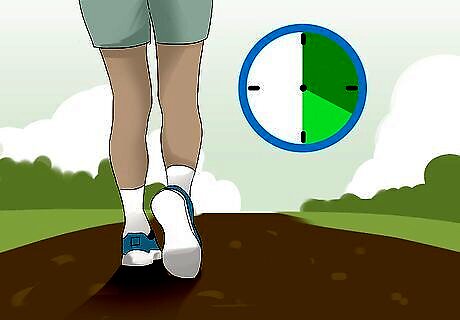
Walk briskly for 20 to 30 minutes per day. Walking is a good beginner's activity if you're just starting to get back into shape, since you must start slow. Try walking at a lighter pace for about 5 minutes to increase your heart rate. Quicken your pace, try to walk briskly for 20 minutes, then cool down by walking for another 5 minutes at a light pace. Try to slowly increase your pace and distance with each session. Aim to walk for at least 20 or 30 minutes a day for 1 or 2 weeks, then start adding other activities to your routine. You could also add light to moderate weights to gradually increase intensity. While you walk, wear a backpack with weights, a weighted walk vest, or ankle and wrist weights, or hold a dumbbell in each hand. It's okay if you can't walk briskly for 20 or 30 minutes without stopping. If necessary, keep your pace light and walk for 10 minutes or so at a time.
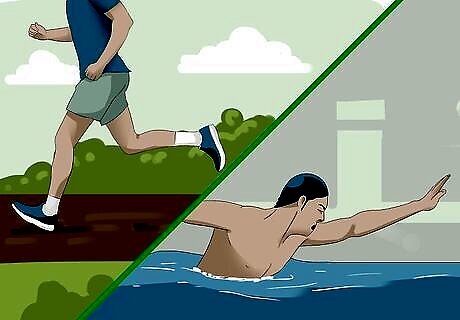
Try activities such as jogging, cycling, swimming, and hiking. Once you've started to get your body used to being active, try doing more varied, challenging activities. Jogging, riding your bike, using a treadmill or stationary bike, and swimming laps are all good forms of aerobic exercise and can add variety to your exercise plan. For any activity, remember to go easy at first and gradually increase your intensity. For instance, try cycling at about 10 mph (16 kph) for 5 minutes, increase your speed to 12 mph (19 kph) for 5 minutes, top off at 15 mph (24 kph) for 5 minutes, then cool down at 10 mph (16 kph) for 5 minutes. The next week, increase your speed at each interval by about 2 mph (3 kph) and cycle at faster speeds for 2 to 5 minutes longer. Then continue to increase your speed and time gradually each week.
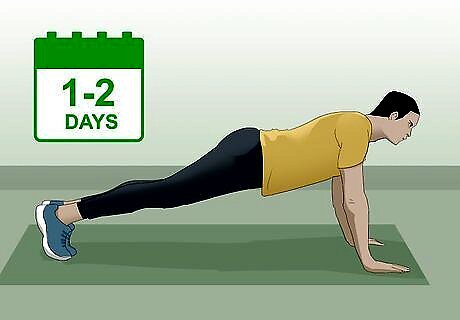
Add 1 to 2 days of strength training to your routine. For a basic upper body strength training workout, try doing 12 to 15 push-ups and pull-ups, and 2 to 3 reps of 30-second planks. Lower body exercises include squats, lunges, and hamstring curls. You can also try lifting free weights or using resistance machines at a gym. For each strength training exercise, just do 1 set of 12 to 15 reps at first, then try doing 2 sets of 8 to 10 reps. Each week, add 1 to 2 reps to each set. If you're lifting, increase your weights by no more than 5% every 1 to 2 weeks.Choosing Weights: Your weights should be light enough that you can maintain proper form and complete 12 reps without straining yourself. When in doubt, stay safe and go with a lighter option, especially when you're just beginning.
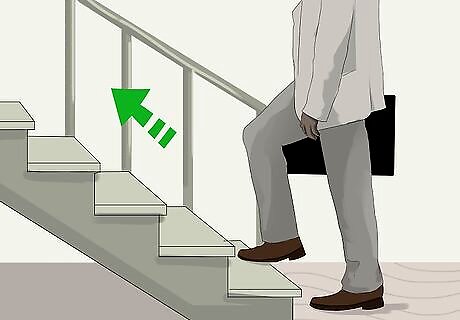
Find ways to make routine tasks more active if your schedule is packed. If you're struggling to squeeze exercise into a busy schedule, there are plenty of solutions at your disposal. For instance, you could go for a walk on your lunch break, take the stairs at work or school, do squats while cooking dinner, and park far away from the entrance of the grocery store. Instead of driving, try to ride a bike or walk whenever possible. If, for instance, work is too far away to ride your bike or walk the whole way, you could also combine walking or cycling with public transportation. If you have kids, trade babysitting duties with another parent. They could watch the kids while you hit the gym, then you could return the favor later in the week. Fitting in the recommended 30 minutes of exercise a day is tough if you're always busy. However, keep in mind you can break that up into smaller increments. Exercising for 10 minutes 3 times a day still counts!
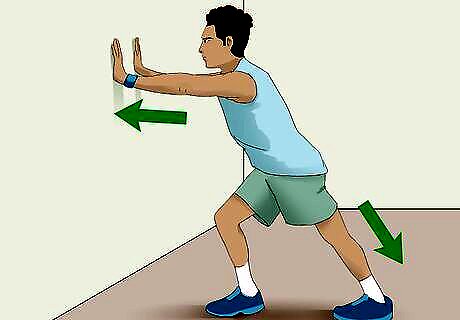
Build your flexibility with light stretching. It's best to do flexibility exercises when your muscles are warm, so stretch after a workout. Breathe while you stretch, use smooth motions instead of bouncing, and stop stretching if it's painful. Try basic stretches, such as: Calf stretch: Stand with your palms against a wall and step forward with your right foot. Keep your left leg extended, and bend your right knee until you feel a stretch in your left calf. Exhale as you hold the stretch for 30 seconds, and do 3 to 5 reps per leg. Thigh stretch: Using a chair for support, raise your left foot toward your rear end, and grasp it with your left hand. Gently pull until you feel a stretch in your left thigh, hold it for 30 seconds, then repeat 3 to 5 times per leg. Upper body stretch: Stand slightly farther than arm's length from a wall. Place your palms against the wall, then walk them upward until your arms are above your head and you feel a stretch your chest. Hold it for 30 seconds, then repeat 3 to 5 times.
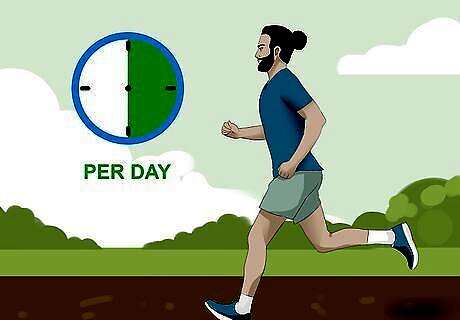
Exercise for gradually longer than 30 minutes per day. Getting the recommended minimum 30 minutes of daily exercise is a good initial goal. However, as you get back into shape, aim to push yourself beyond that minimum. Bit by bit, make your workouts longer and more challenging and push yourself to achieve new fitness goals. For instance, add 5 to 10 minutes to your walks, runs, and cycling sessions each week. Try to eventually get at least 300 minutes of exercise per week, or 45 to 60 minutes per day. Remember to talk to your doctor about increasing your activity level, especially if you have a history of medical issues.
Motivating Yourself to Stay in Shape

Write down your exercise plan and goals. Put your plans on paper and post them in a prominent place. List your workout days and the activities you plan on doing in your agenda, on a calendar, or on a poster. Writing your goals or pasting images that represent them on a vision board can also inspire you to stay committed.Set SMART Goals: Good goals are Specific, Measurable, Achievable, Realistic, and Time-related. Examples include “Cycle for 30 minutes 4 times a week” and “Run 1 mile (1.6 km) in 10 minutes by week 6 of training.” You can also set loftier long-term goals, but lay out a clear path for achieving them, such as, “Run a marathon within 2 years of beginning training.” Keeping track of your exercising will help you stay accountable and motivated while also giving you a visual on your progress. This can be a great tool for you to continue to be committed to your fitness goals.

Identify exercises and activities that you enjoy most. You're more likely to stick with your fitness plan if you make exercise fun. Maintain a positive attitude and do activities that you enjoy. Try not to see exercise as a chore, duty, or source of stress. For instance, if you love fresh air and nature, go for hikes or take up rock climbing. If you love spending time with your dog, go for daily brisk walks or jogs together. If you're a music aficionado, play your favorite fast-paced tunes during your workouts.

Exercise with a friend or join a class to hold yourself accountable. Find an exercise buddy and hit the gym, go for runs, or ride your bikes together. Make a pact to hold each other accountable, and offer each other encouragement when the going gets tough. You could also sign up for a team sport, like a local kickball league, or take a group class, such as a yoga, Pilates, or spin class. If you have a partner or kids, you could also get more active as a family. Go for walks, bike rides, and hikes together, or head to the park for weekend field days.
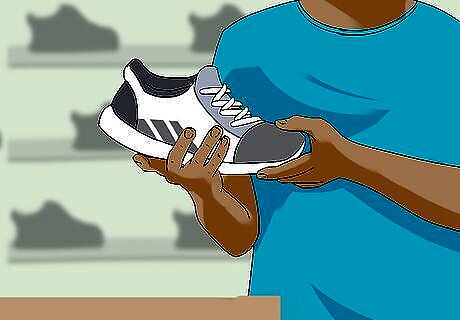
Reward yourself for staying on track. Give yourself rewards for both major and minor accomplishments. Try to think of a variety of small and large rewards that will provide motivation. For instance, if you've stuck to your exercise routine for 2 weeks straight, you could treat yourself to a new article of clothing, accessory, or workout gear. Try not to choose counterproductive rewards. For instance, skipping workouts for a week wouldn't make a good reward since it would get in the way of your progress.
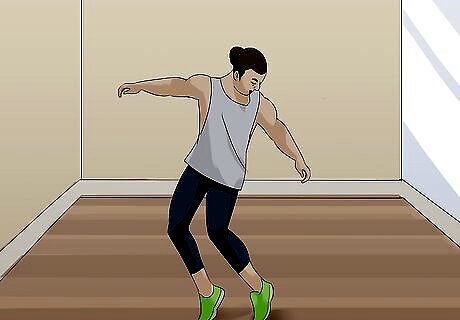
Mix up your routine to keep things interesting. Establishing a routine can help you build healthy habits, but things can get boring if your schedule is too strict. Do a variety of activities instead of sticking to the same exact fitness plan week after week. If your results have stalled or things start feeling stale, take up a new fitness-related activity. For instance, you could switch things up and take a dance, rock climbing, or martial arts class. You could also mix things up by setting a new fitness goal, such as running in a long-distance race or climbing a difficult mountain.

Don't let roadblocks or setbacks discourage you. No one's perfect, and sickness, vacations, and hectic weeks at work will happen. It's okay if you miss a workout or start to lose focus. However, don't be hard on yourself, do your best to stay positive, and remind yourself that your goals are important. If you're feeling down, you could also reach out to a supportive friend or relative for a pep talk. Additionally, don't allow obstacles to become excuses. For instance, if it's pouring outside and you can't go for a walk, head to a mall and walk laps indoors.
Boosting Your Activity Level Safely

Start and progress slowly if you're not used to being active. Even if you used to be in great shape but haven't been active in a few months, you can't just resume exercising at the same intensity level. To avoid injury, ease yourself in with flexibility training and walking for 1 to 2 weeks, then gradually add more strenuous exercises to your routine. Your strength and endurance can diminish by 50% or more after 4 months without exercise. However, don't feel discouraged! You'll get back into shape before you know it!Safety Precaution: It's best to consult your doctor before starting a new exercise routine, especially if you have a history of any medical conditions. If you're trying to get back to exercising after a pregnancy, check with your doctor to see what your limitations might be. You definitely want to start easy.
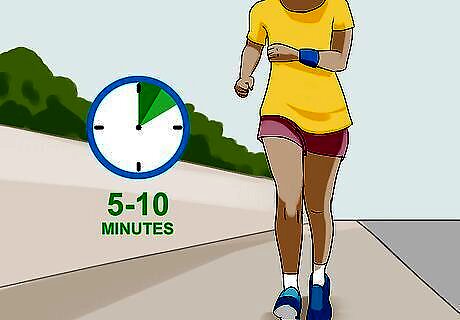
Warm up and cool down before and after exercising. Before your workouts, walk at a steady pace for 5 to 10 minutes to increase blood flow to your muscles. After working out, walk for another 5 to 10 minutes to ease your body back into a resting state. Be sure to warm up before any form of exercise, including stretching. Working out or stretching cold muscles can lead to injury. Cooling down flushes wastes from your muscles produced during exercise, which helps prevent cramps.
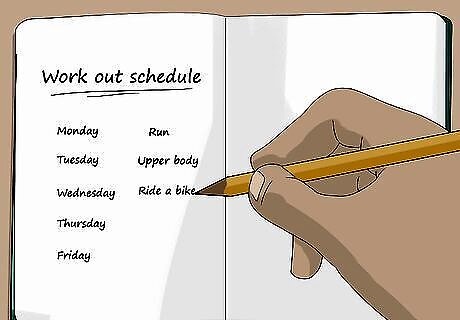
Include a recovery day between workouts. Your body needs time to rest, so avoid targeting the same muscle group 2 days in a row. For instance, go for a run on Monday, do upper body strength training on Tuesday, and ride your bike on Wednesday. Rest a muscle group after a moderate or high intensity workout, but don't feel like you can't go for a walk 2 days in a row. Listen to your body, and avoid exercising if you're in pain.
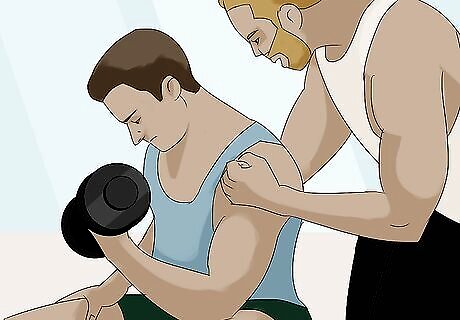
Consult a fitness professional or physical therapist about proper form. If you're new to lifting, running, and other forms of strenuous exercise, it's wise to seek advice about correct technique from a physical therapist. Hiring a trainer, working with a gym instructor, or enrolling in a class could also help you learn proper form. When you're lifting or stretching, always use smooth, steady motions, and keep breathing while you complete a rep. Never use bouncing or jerking motions or try to extend past your natural range of motion. Additionally, ask your doctor about particular exercises you should do and which you should avoid given your condition. Don't rely on the advice of a personal trainer or other fitness professional instead of talking to your doctor.




















Comments
0 comment